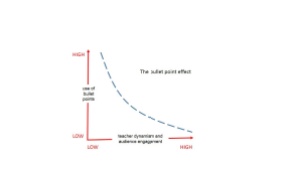By Ian Kinchin
There is a plague that has infected higher education over the past decade. One that has been so invasive that it has changed the habits of teachers and the expectations of learners in ways that are quite profound, but have gone largely unnoticed. I am talking about the infestation of lectures with bullet points.
It is a hobby-horse of mine, but I am sick of watching bullet points (especially when presenters think it is cool to have them zooming in from the side of the screen, one-by-one), and I regard it as a sickness among our colleagues that needs to be treated.
Students have asked me if university teachers are instructed to read out bullet points during their lectures. I obviously say, ‘no’, to which the students reply, ‘so why do they do it?’. Everyone I speak to tells me that reading points to students in lectures is bad practice, and yet there appears to be a form of pedagogical paralysis that prevents some colleagues from breaking free of this affliction.
There are a number of assumptions that I make in my mind (fairly or unfairly) about presentations that consist of nothing but bullet points. I assume that the presenter lacks the imagination to offer anything other than bullet points (the greasy-spoon mentality of ‘chips with everything’). I assume that the presenter is lazy, and cannot be bothered to present materials in a more engaging way. I assume that perhaps the presenter doesn’t know the content well enough to transform the content into a different format. I presume that the presenter has not been able to construct a coherent schema in his/her mind and so has to work with atomised chunks of content – whilst expecting me to generate some coherence from the presentation.
I even think there is a direct correlation between the extent of bullet point usage in a presentation and the level of teacher dynamism and audience engagement, the “bullet point effect”:
PDF of figure: The bullet point effect
For these reasons, I have all but given up going to keynote lectures at conferences. By the time I get to the third or fourth slide of bullet points I have switched off. And I am not alone. I make a point now of sitting near the back of the audience during these sessions; partly so that I can make a quick getaway if it gets too boring. But more interestingly, so that I can observe the audience to see what they are doing. From the speaker’s perspective, it often looks like the audience is engaged and they are busy typing down the pearls of wisdom on their laptops and tablets. From the back what you see is a sea of screens on which the audience are busy responding to their e-mails.
I was sat in the audience of a keynote a few years ago next to a colleague who knew of my hatred of bullet points. Six slides in and we hadn’t seen anything but bullets. Then the presenter announced the next slide as “the triangle of research”. My ears pricked up and I looked at the screen in anticipation of a geometric depiction of said triangle. What did we get? Three bullet points. To which I said to my colleague, “where’s the triangle?”. His response, “I suppose we have to presume it is in his head – so I wonder who the slide is for?”.
There are exceptions. There are presentations that have been really good. But there seems to be a correlation (at least in my mind) about the quality of the PowerPoint and the quality of the presentation. Some excellent presentations have used PowerPoint, but to show things that cannot be adequately summarised in bullets. Things like graphs, maps and photos. I have even been to presentations where PowerPoint has not been used at all. Imagine! Yes, it can be done. One of the best presentations I have been to recently used a single slide – an image that was the focus of the lecture. Also, colleagues need to remember that PowerPoint can be turned off for part of a presentation – just press ‘B’ on the keyboard and the screen will go black.
I was recently unable to attend a presentation in London. One that sounded potentially very interesting and was to be led by the great and the good. Although in the end I couldn’t go, I was pleased that the organisers would send me copies of the presentations from the day. When the files arrived in my e-mail, I was eager to see what I had missed. Unfortunately, all I got was a lot of bullet points. From this I was unable to determine if there was any coherence or innovation in the ideas that had been presented. It was like seeing the chapter headings from a book. Useless!
One year, a group of us did hatch a plan to produce Tee shirts for a conference with the logo:
“STOP USING BULLET POINTS – THEY RESULT IN NON-LEARNING”.
Perhaps next year, unless a cure is found in the meantime.
Reference
Kinchin, I.M., Lygo-Baker, S. and Hay, D.B. (2008) Universities as centres of non-learning. Studies in Higher Education, 33(1): 89 – 103.
Professor Ian Kinchin is Head of the Department of Higher Education at the University of Surrey, and is also a member of the SRHE Governing Council. This post was first published on Ian’s personal blog, https://profkinchinblog.wordpress.com and is reproduced here with the author’s permission.




